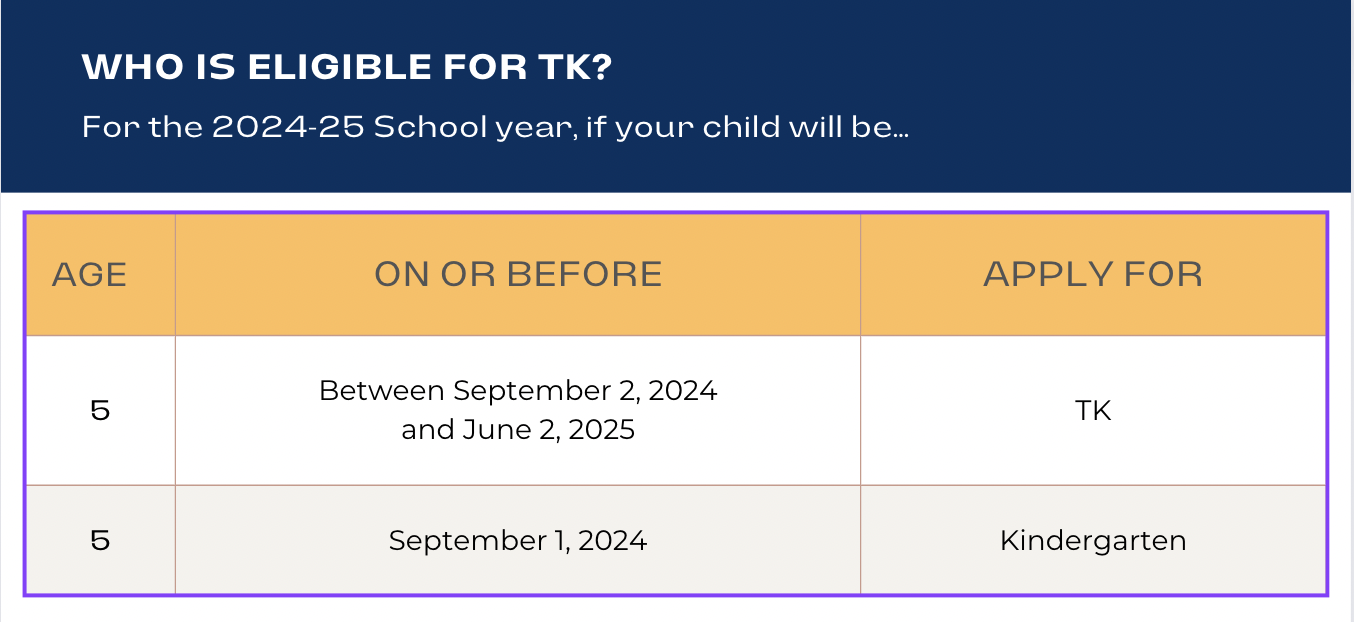Applying to Transitional Kindergarten (TK)
Please call the office at (415) 337-0100 before submitting an application.
In 2024-25, children are eligible for TK if they turn 5 years old between
September 2, 2024 and June 2, 2025. See below for additional age requirements.
September 2, 2024 and June 2, 2025. See below for additional age requirements.
- Applicants must provide an original, official, embossed birth certificate.
- Catholic students must also present an original copy of their baptismal certificate. Once the originals are seen, a copy will be made and we will immediately return them to you.
- All TK applicants will be evaluated and assessed for readiness to enter our TK program.
- Complete the ONLINE application.
- Parents' Guide to Immunizations
About Transitional Kindergarten (TK)
The Kindergarten Readiness Act of 2010 changed the required birthday for admission to kindergarten and first grade and established a Transitional Kindergarten (TK) program. To ensure that all children enter kindergarten at age 5 the law now requires that students entering kindergarten are 5 years old on or before September 1st. SB 1381 (Chapter 705, Statutes of 2010) amended EC sections 46300, 48000, and 48010.
Transitional Kindergarten provides children with the gift of time to learn skills that will help them build a strong foundation for success in elementary school. Readiness for school includes practical skills that children need to succeed, as well as social emotional skills that help them to successfully function in a classroom of peers.
Transitional Kindergarten ensures that families have an additional option to ensure their children enter kindergarten with the maturity, confidence and skills they need to excel. Our school will benefit because children not only learn essential pre-literacy, pre-math, and other cognitive skills, but also develop social and self-regulation skills needed to succeed in school and life.
How is Transitional Kindergarten different from Preschool?
How is Transitional Kindergarten different from traditional Kindergarten?
What grade will children go into after Transitional Kindergarten?
Are students in TK also subject to the kindergarten immunization requirements?
What is the tuition rate for Transitional Kindergarten?
What are the school hours for a TK student?
What are the age requirements for Transitional Kindergarten?
The Kindergarten Readiness Act of 2010 changed the required birthday for admission to kindergarten and first grade and established a Transitional Kindergarten (TK) program. To ensure that all children enter kindergarten at age 5 the law now requires that students entering kindergarten are 5 years old on or before September 1st. SB 1381 (Chapter 705, Statutes of 2010) amended EC sections 46300, 48000, and 48010.
Transitional Kindergarten provides children with the gift of time to learn skills that will help them build a strong foundation for success in elementary school. Readiness for school includes practical skills that children need to succeed, as well as social emotional skills that help them to successfully function in a classroom of peers.
Transitional Kindergarten ensures that families have an additional option to ensure their children enter kindergarten with the maturity, confidence and skills they need to excel. Our school will benefit because children not only learn essential pre-literacy, pre-math, and other cognitive skills, but also develop social and self-regulation skills needed to succeed in school and life.
How is Transitional Kindergarten different from Preschool?
- The standards, curriculum and teaching requirements in transitional kindergarten will be different from preschool. Transitional Kindergarten will be part of the K-12 public education system and it will be based on the kindergarten standards. It will build on the skills children may have learned in preschool to ensure they will be able to begin kindergarten with confidence.
How is Transitional Kindergarten different from traditional Kindergarten?
- Although the curriculum in Transitional Kindergarten will be based on the kindergarten standards, it will be modified to meet the academic, social and emotional needs of younger children.
- The Transitional Kindergarten environment will include more opportunities for social-emotional, language development and communication through dramatic play; small group instruction; and intentional teaching through hands-on activities.
What grade will children go into after Transitional Kindergarten?
- Transitional Kindergarten is the first year of a two-year kindergarten experience. Most children will go on to kindergarten after completing transitional kindergarten.
- Transitional kindergarten serves as a bridge between preschool and kindergarten, giving children more time for hands-on, interactive learning. It also gives children the opportunity to spend time learning important social, emotional and academic skills that will help them succeed in kindergarten and beyond.
- California’s kindergarten curriculum and standards have changed over the years, and many of the skills children were once taught in first grade are now taught in kindergarten. TK is a program that uses modified kindergarten curriculum that is age and developmentally appropriate.
Are students in TK also subject to the kindergarten immunization requirements?
- Yes. They are required to have documentation of required immunizations and physical prior to admission to TK.
What is the tuition rate for Transitional Kindergarten?
- The rate is the same as a K-8 student. Refer to our Tuition and Fees page.
What are the school hours for a TK student?
- Transitional Kindergarten follows the same hours and holidays schedule as students in K-8 grade. School begins at 8:10am each morning. Dismissal on Mondays-Thursdays is at 2:45pm and at 2:15pm on Fridays. On minimum days, students will dismiss at 12:15pm.
What are the age requirements for Transitional Kindergarten?
- Students applying for Transitional Kindergarten need to turn five years old by the dates listed in the graphic below.
|
St. Thomas More School 50 Thomas More Way San Francisco, CA 94132 www.stthomasmoreschool.org Main Office: (415) 337-0100 Fax: (415) 333-2564 Email: [email protected] |
|



